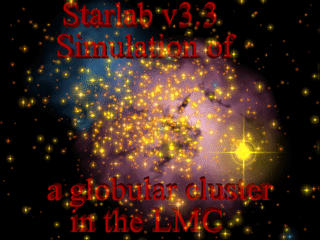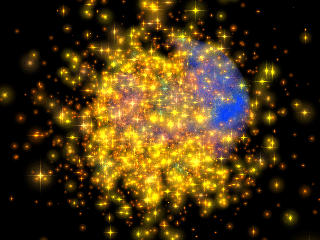Animation of a young star cluster
(mirror in
Tokyo
and Amsterdam)
MPEG animation(9Mb)
of the simulated star cluster 12W6A10 (see Portegies Zwart et al.
1999). The animation starts at 3 Myr and continues until
6 Myr. In the beginning we look at the density center of the cluster
from a distance of 30 parsec. Then we zoom-in in a million years with
a velocity of 30 km/s to a distance of 3 pc. The time between two
frames corresponds to about 1850 years (one sixteenth of a crossing
time at the half mass radius). The frame has a size of about 2 by 1.5
parsec.


The colors of the stars represent their effective temperature. A
collision product flares up in bright white (five
events). A supernova which produces a black hole (two events) gives a bright violet flash followed by an
expanding shell (right picture). The formation
of a neutron star (two events) produces a similar
expanding shell but the flash is greenish.
Initially the cluster contains 12288 stars taken randomly from an
initial mass function similar to that in the Solar neighborhood. The
initial relaxation time of the cluster is 10 million years, the half
mass crossing time is 82 000 years. The initial core radius is 0.07
parsec and the half mass radius is 0.25 parsec.
All calculations are performed on the GRAPE-4 at
Tokyo University using the starlab
toolset. The trajectories of the stars are calculated with kira and
the evolution of the stars was computed with SeBa (for
details see Portegies
Zwart, Makino, McMillan and Hut 1999, Astronomy & Astrophysics 348,
117).
The animation is made by Simon Portegies Zwart
using povray 3.0. The star ships are constructed by D. Beattie and are
copyright (c) of Lucasfilm Ltd (without permission). Chris
Colefax is acknowledged for his assistance in making the stars look
more realistic.

